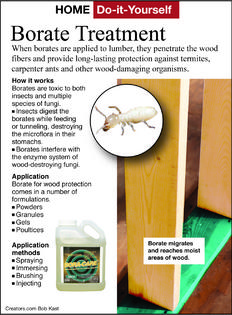Here's How: Use Borate To Preserve Lumber
Dear James: We have problems with insect damage in our area. When doing a major remodeling project, should we treat all the lumber with spray-on borate chemicals for protection? -- Brittany K.
Dear Brittany: It is surprising how fast termites or carpenter ants can hollow out a piece of lumber. You may not notice it for quite a while until you see a spot on the wood surface. The wood can literally collapse when you push on it. Once you find a problem, it is very difficult to get access to completed structures.
Pretreating all the lumber with borate chemicals is an excellent option. Borate chemicals protect the lumber from termites, carpenter ants, old house borers, beetles, silverfish, cockroaches, etc., and also from brown and white fungi and wet rot which can slowly cause the wood to deteriorate.
The advantages of treating lumber with borate chemicals, as opposed to other professionally applied chemicals, is that they are not highly toxic to people or mammals. Avoid getting excessive amounts of it on plants or in ponds with fish.
Once the wood is treated with borate chemicals and dries, the appearance of its surface is still similar to untreated lumber. You can still use saws, nails, screws, etc., exactly like untreated lumber. Borate chemicals will not corrode metal fasteners, and they are reasonably priced.
Most home center stores, building supply outlets and paint stores should sell borate chemicals. If you have any trouble finding them, try these two companies for the names of local retail outlets: Sashco Sealants and Saver Systems.
Borate chemicals belong to a class of wood treatments that diffuse and actually penetrate deep into the wood surface as opposed to a surface coating like paints. It can penetrate up to an inch deep. When the insects chew on the wood, the borate blocks up their digestive tract and they die. Many of the worker insects also carry the borate-treated wood fibers back to the nest.
The simplicity of using borate chemicals to treat wood is also their primary drawback. Borate chemicals are typically sold as a powder that you dissolve in water and then apply by any of the above methods. Since it is water-soluble, it can slow leach back out of the lumber if it becomes damp. Over time, it will lose its insect- and fungi-fighting properties.
It is imperative to treat all the surfaces of the lumber, especially the cut ends. Talk with your contractor about having the majority of the framing lumber delivered after part of the new room addition is protected from the rain. Treat all the ends of the lumber with borate at one time while the lumber is still strapped and bundled together.
As with all treatment methods, make sure the wood surface is clear of dirt, waxes, oils, mold or anything else that will block the borate solution from the pores in the wood.
Follow the manufacturer's instructions for mixing the borate powder with water. Typically, 1 pound of borate powder is mixed with 1 gallon of water. That 1 gallon of borate solution should treat about 200 square feet of lumber surface area. When spraying, as opposed to brushing, there is some waste, so the coverage may be less.
Borate chemical solution can be applied by any standard method -- brushing, spraying, flooding or immersing in a bath. Spraying, using a common hand pump sprayer, is probably the easiest and most effective application method for the do-it-yourself homeowner.
If you can find a long trough, immersing the lumber completely provides the deepest penetration of the borates. Leaving it immersed for about 3 to 5 minutes is usually long enough. Over a week or so, the borate chemicals will slowly penetrate even deeper to about a 1-inch depth.
========
Send your questions to Here's How, 6906 Royalgreen Dr., Cincinnati, Ohio, 45244 or visit www.dulley.com. To find out more about James Dulley and read features by other Creators Syndicate writers and cartoonists, visit the Creators Syndicate website at www.creators.com.
Copyright 2024 Creators Syndicate Inc.






























Comments